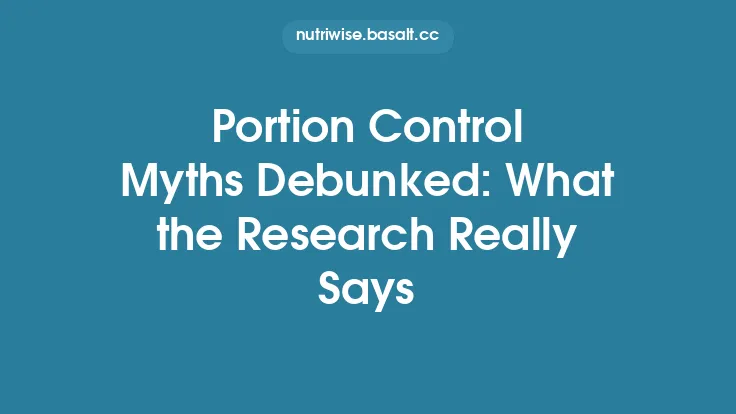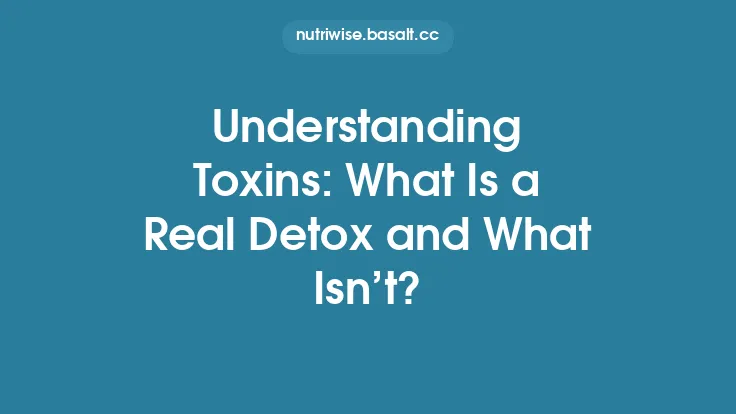The market for “detox” teas has exploded in recent years, promising everything from rapid weight loss to a reset of the body’s internal balance. Shelves are lined with colorful boxes that tout “cleanse,” “flush,” and “purify,” while influencers share before‑and‑after photos that suggest dramatic results after just a few days. Yet, when you step back from the marketing hype and look at the peer‑reviewed literature, the picture is far more nuanced. Below is a comprehensive, evidence‑based examination of detox teas, covering what they are, how they are supposed to work, what research actually says, and what consumers should keep in mind before reaching for that next cup.
What Are “Detox” Teas?
Detox teas are blends of dried herbs, leaves, roots, and sometimes added extracts that are marketed as agents that help the body eliminate toxins, reduce bloating, and promote weight loss. They are typically sold as:
- Pre‑packaged single‑serve bags (e.g., “7‑Day Cleanse”)
- Loose‑leaf blends for brewing at home
- Powdered mixes that can be dissolved in hot water
The term “detox” is not regulated, so manufacturers can label a product as a detox tea even if it contains only common culinary herbs. The key distinction from ordinary herbal tea is the claim that the blend triggers a physiological cleansing process beyond what a regular cup of green or black tea would provide.
Common Ingredients and Their Claimed Effects
| Ingredient | Traditional Use | Primary Claim in Detox Teas | Mechanistic Rationale (if any) |
|---|---|---|---|
| Senna (Cassia angustifolia) | Laxative in traditional medicine | “Flush out waste” | Contains anthraquinone glycosides that stimulate colonic peristalsis, increasing bowel movements. |
| Dandelion (Taraxacum officinale) leaf/root | Diuretic, liver support in folk medicine | “Reduce water retention” | Contains potassium salts and sesquiterpene lactones that may increase urine output via inhibition of Na⁺/K⁺‑ATPase in renal tubules. |
| Garcinia cambogia | Appetite suppressant in some cultures | “Burn fat” | Hydroxycitric acid (HCA) is thought to inhibit ATP‑citrate lyase, a key enzyme in de novo lipogenesis, though human data are mixed. |
| Green tea (Camellia sinensis) extract | Antioxidant, mild stimulant | “Boost metabolism” | Catechins (especially EGCG) can modestly increase thermogenesis and fat oxidation; effect size is small (≈3–4% increase in resting energy expenditure). |
| Cascara (Rhamnus purshiana bark) | Traditional laxative | “Cleanse colon” | Contains anthraquinones similar to senna, promoting bowel motility. |
| Licorice root (Glycyrrhiza glabra) | Soothing, anti‑inflammatory | “Support adrenal health” | Glycyrrhizin can affect cortisol metabolism, but at high doses may cause hypertension and hypokalemia. |
| Lemon peel/powder | Flavor, vitamin C source | “Alkalize body” | No credible evidence that dietary lemon changes systemic pH; vitamin C is an antioxidant but not a detox agent. |
| Cinnamon (Cinnamomum verum) | Flavor, blood‑sugar modulation | “Stabilize glucose” | May improve insulin sensitivity modestly; effect is dose‑dependent and not sufficient for clinical impact. |
Many blends combine several of these ingredients, hoping that their individual actions will synergize. However, synergy is rarely demonstrated in controlled trials, and the cumulative effect is often limited to the most pharmacologically active component—usually a laxative or diuretic herb.
The Science Behind Diuretic and Laxative Actions
Diuretic Effects
A handful of studies have examined the acute diuretic response to dandelion leaf extracts. In a crossover trial with 12 healthy adults, a single 500 mg dose of standardized dandelion leaf extract increased urine volume by an average of 250 mL over 6 hours compared with placebo (p = 0.04). The effect was modest and transient, returning to baseline within 24 hours. Importantly, the study reported no significant changes in serum electrolytes, suggesting that short‑term use is unlikely to cause electrolyte imbalance in healthy individuals. However, repeated daily consumption could theoretically lead to mild hypokalemia, especially when combined with other potassium‑depleting agents (e.g., laxatives).
Laxative Effects
Anthraquinone‑containing herbs such as senna and cascara are well‑studied for their stimulant laxative properties. A meta‑analysis of 9 randomized controlled trials (RCTs) involving 1,023 participants found that senna increased stool frequency by 1.8 bowel movements per day compared with placebo (95% CI 1.4–2.2) and reduced transit time by roughly 30 %. The effect is dose‑dependent, with typical commercial doses (≈50 mg anthraquinone glycosides) producing a noticeable laxation within 6–12 hours.
While these agents are effective for short‑term constipation relief, chronic use can lead to:
- Melanosis coli – a brownish discoloration of the colon mucosa that is reversible upon cessation.
- Electrolyte disturbances – especially loss of potassium and magnesium.
- Dependence – reduced colonic motility when the stimulant is withdrawn.
Detox teas that rely heavily on these laxatives essentially function as short‑term bowel‑cleansing products rather than systemic detoxifiers.
Clinical Evidence on Weight Loss and Metabolic Impact
The most common consumer claim is that detox teas facilitate rapid weight loss. The literature distinguishes between water weight (loss of excess extracellular fluid) and fat loss (reduction of adipose tissue). Most studies on detox‑tea ingredients report:
- Transient water loss – Diuretic herbs can reduce body weight by 0.5–1 kg within 24 hours, but the effect dissipates once fluid balance normalizes.
- Modest fat oxidation – Green tea catechins, when consumed at 300–500 mg EGCG per day, have been associated with a 2–4% increase in fat oxidation during moderate exercise. However, the absolute impact on body composition over weeks is minimal (≈0.2 kg of fat loss over 12 weeks in a well‑controlled trial).
- No sustained weight‑loss advantage – A 12‑week RCT comparing a commercial “detox tea” (containing senna, dandelion, and green tea extract) to a placebo tea in 84 overweight adults found no significant difference in body weight, BMI, or waist circumference at study end (p > 0.2). Both groups experienced similar reductions in bloating, likely due to the laxative component.
Overall, the evidence suggests that any short‑term weight reduction observed with detox teas is primarily due to fluid loss and increased bowel movements, not a true reduction in adipose tissue. Long‑term weight management still hinges on caloric balance, physical activity, and sustainable dietary patterns.
Potential Risks and Side Effects
| Risk | Mechanism | Typical Onset | Severity |
|---|---|---|---|
| Dehydration | Excessive diuresis or laxation → fluid loss | Within 24 h of use | Mild to moderate; can exacerbate in hot climates or with vigorous exercise |
| Electrolyte Imbalance | Loss of Na⁺, K⁺, Mg²⁺ via urine or stool | 2–5 days of continuous use | Can cause muscle cramps, arrhythmias in susceptible individuals |
| Gastrointestinal Irritation | Anthraquinone irritation of colonic mucosa | 1–3 days | Cramping, urgency, occasional diarrhea |
| Drug Interactions | Senna can increase absorption of certain medications (e.g., digoxin) by altering gut motility | Variable | May require dose adjustment of concurrent drugs |
| Allergic Reactions | Plant‑derived allergens (e.g., ragweed cross‑reactivity with dandelion) | Immediate to delayed | Rash, itching, rarely anaphylaxis |
| Pregnancy/Lactation Concerns | Laxatives are generally contraindicated due to uterine stimulation | Throughout pregnancy | Potential risk of uterine contractions, fetal distress |
Regulatory agencies such as the U.S. Food and Drug Administration (FDA) classify most detox teas as dietary supplements, which means they are not required to undergo pre‑market safety testing. Consequently, adverse event reporting is largely passive, and the true incidence of serious side effects may be under‑captured.
Regulatory Landscape and Quality Concerns
- Labeling Ambiguity – Because “detox” is not a defined term, manufacturers can list vague ingredient names (“herbal blend”) without specifying exact botanical parts or concentrations. This hampers reproducibility and safety assessment.
- Contamination Risks – Analyses of imported herbal teas have identified heavy metals (lead, cadmium) and pesticide residues exceeding permissible limits in up to 12% of samples. Routine third‑party testing is not mandatory.
- Adulteration – Some products have been found to contain undeclared pharmaceutical agents (e.g., sibutramine, a banned appetite suppressant). The FDA’s “Detox Tea” warning letters from 2022–2024 highlight several cases where products were seized for containing such hidden drugs.
- Health Claims Enforcement – Claims that a product “detoxifies the body” or “burns fat” are considered structure‑function statements. If a company markets a product with disease‑prevention language (e.g., “prevents liver disease”), the FDA may deem it an unapproved drug claim and issue a warning.
Consumers seeking a trustworthy product should look for:
- Third‑party certifications (e.g., USP, NSF) confirming identity and purity.
- Transparent ingredient lists with botanical Latin names, plant part used, and standardized extract ratios.
- Absence of “proprietary blend” terminology that obscures exact dosages.
How to Evaluate a Detox Tea Product
| Evaluation Step | What to Look For | Why It Matters |
|---|---|---|
| Ingredient Transparency | Full Latin names, plant part, extraction method, dosage per serving | Enables cross‑checking with scientific literature and safety data |
| Evidence of Standardization | % of active marker compounds (e.g., 0.5% anthraquinones for senna) | Guarantees consistent potency across batches |
| Third‑Party Testing | Certificates of analysis (CoA) for contaminants and active ingredients | Reduces risk of heavy metals, pesticides, or adulterants |
| Regulatory Status | “Dietary supplement” label with clear disclaimer that claims are not evaluated by FDA | Indicates compliance with current regulations |
| Consumer Reviews & Adverse Event Reports | Look for patterns of gastrointestinal upset, electrolyte issues, or lack of effect | Real‑world data can highlight problems not captured in studies |
| Price vs. Ingredient Cost | Extremely low price may signal sub‑therapeutic dosing or poor quality | Ensures you are not paying for a product that delivers negligible active compounds |
Practical Recommendations for Consumers
- Treat Detox Teas as Short‑Term Aids, Not Long‑Term Solutions – If you choose to use a tea for mild bloating relief, limit intake to 3–5 days and monitor fluid and electrolyte status.
- Stay Hydrated – Counterbalance diuretic or laxative effects by drinking at least 2 L of water per day, especially if you are physically active.
- Avoid Concurrent Use of Multiple Laxatives – Combining a detox tea with over‑the‑counter stool softeners or stimulant laxatives can amplify electrolyte loss.
- Consult a Healthcare Professional – Individuals with kidney disease, heart conditions, hypertension, or those taking medications that affect electrolyte balance should seek medical advice before using any product containing senna, dandelion, or similar herbs.
- Prioritize Whole‑Food Strategies for “Detox” – A diet rich in fruits, vegetables, adequate protein, and regular physical activity naturally supports the body’s endogenous clearance pathways without the risks associated with herbal stimulants.
- Be Skeptical of Grand Claims – If a product promises “5 kg of fat loss in 7 days” or “complete toxin elimination,” it is likely exaggerating. Look for modest, evidence‑backed outcomes instead.
Bottom Line
Detox teas are a heterogeneous group of herbal blends that primarily rely on diuretic and laxative ingredients to produce rapid, short‑term reductions in water weight and intestinal contents. The scientific literature confirms that these mechanisms work as advertised, but the effects are transient and do not translate into meaningful fat loss or long‑term health benefits. Moreover, the same ingredients that drive the desired “cleanse” can also cause dehydration, electrolyte disturbances, and gastrointestinal irritation, especially when used repeatedly or in high doses.
Because the term “detox” is unregulated, product quality varies widely, and some teas have been found to contain contaminants or undeclared pharmaceuticals. Consumers can mitigate these risks by selecting products with transparent labeling, third‑party testing, and standardized extracts, and by limiting use to short periods under the guidance of a healthcare professional.
In short, while a cup of detox tea may help you feel lighter for a day or two, the body’s own metabolic and excretory systems already handle toxin elimination efficiently when supported by a balanced diet, adequate hydration, and regular movement. Relying on a marketed “detox” tea as a primary strategy for weight management or health improvement is not supported by robust research. Use them sparingly, stay informed, and focus on sustainable lifestyle habits for lasting results.





